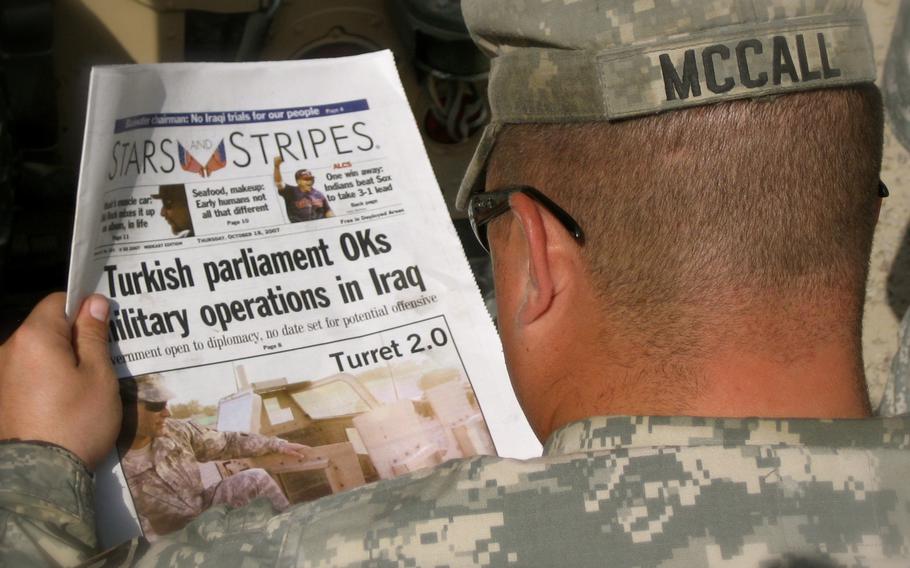
An Army sergeant with the 153rd Military Police Company reads an edition of Stars and Stripes while in the Green Zone, Baghdad, Oct. 18, 2007. (Brendan Mackie/U.S. Army)
Credibility is the lifeblood of a news organization. Without credibility, where is the value? Readers must be able to trust that the news they are receiving is unbiased, truthful and as complete as possible in the moment.
But — and it probably won’t surprise you to hear this — a majority of Americans lack trust in news media. Gallup’s most recent poll, for example, found that trust in mass media is at its lowest point in five decades. More than two-thirds say they either do not trust it “very much” or at all. How can you be well informed if you find the news unreliable?
Stars and Stripes is addressing this situation head-on. It’s not enough anymore to say to readers “trust us;” the basis for trust must be explained and earned; the reporting and editing of the news must be transparent.
Stripes is doing this through a recently adopted statement of Core Values. This is different from its Mission Statement, which explains its purpose. Core Values get to the heart of how a news organization ought to work.
“Credibility is the greatest asset of any news medium, and impartiality is its greatest source of credibility,” the statement begins. “Impartiality means reporting and editing the news honestly, fairly, and objectively without personal opinion or bias. Journalism’s core mission is truth-telling, which requires accurately reporting facts and context.”
Can journalists truly be impartial? When I was a reporter at various newspapers in the Northeast, every once in a while someone I was interviewing would say accusingly that it’s impossible to be objective. That’s actually an interesting debate. My response was that reporters are trained to put aside their personal views and pursue the facts.
I was encouraged to see objectivity addressed this way in Stripes’ Core Values: “A journalist’s role is not to determine what they believe to be the truth and reveal only that to their readers. They must report all verifiable facts as completely and impartially as possible, so that readers can, based on their own knowledge and experience, determine what they believe to be true.”
This is a crucial distinction: The news does not aim to tell readers what to think. More on that in a moment.
On objectivity, I particularly like this perspective in the Core Values: “A news organization must not just cover the news but uncover it. It must follow the story wherever it leads, without allowing preconceived ideas to filter the search for facts or to replace the discipline of verification.” I wish I had these words for a response back in my reporting days.
Telling readers what to think — or not — can be confusing because on the Opinion page, also called the Editorial page, of most newspapers there are editorials, columns, guest essays and Letters to the Editor espousing many particular points of view. Some newspapers endorse political candidates, a practice that has drawn fresh debate in the industry. But opinion and news are entirely separate, and most newspapers put a wall between the two, similar to the wall between news and advertising. One does not influence the other. I know this first-hand as I was an opinion editor for a chain of daily newspapers for many years.
Stripes takes this wall higher. It does not publish staff-written editorials. “When a news organization delivers both news and opinions, its impartiality and credibility can be questioned,” the Core Values state. “To minimize this, a clear distinction must be made between the two. Stars and Stripes maintains a strict separation between news and opinion. We do not write opinion pieces. Instead, we publish a balanced selection of external viewpoints.” I read the Opinion section every day of publication and can verify the balance.
I believe that Stripes’ position on opinion — unlike most mainstream media — is crucial because of its targeted audience. Stripes is dedicated to providing information to the military community, information that is impartial, unfiltered, factual and fair.
The Core Values statement has been in development for months and involved virtually all staff in Central headquarters in DC, Europe and the Pacific. Stripes Publisher Max Lederer Jr., who initiated the movement, called the statement a defining moment for the newsroom.
“My goal for Stars and Stripes is to be viewed as a credible source, and we achieve this by impartial truth-telling in all that we publish,” Lederer said in announcing this month adoption of the Core Values. “It is important that the military community understands what Stripes stands for and our perspective in executing our mission.”
The Core Values align with a national initiative of the Center for Integrity in News Reporting of “restoring trust through impartial, objective, and fair reporting,” said Executive Director Rufus Friday. He also is chair of the Publisher’s Advisory Board for Stripes, which is composed of news industry leaders from around the country.
“Your leadership in defining and embracing these principles sends an important message — not only to the military community you serve, but to the broader journalism world — that credibility is earned through adhering to truth and impartiality,” Friday said.
The Core Values must be prominent on Stripes’ sites as a pledge to readers.
“These principles are not mere slogans,” the Core Values statement reads. “They are commitments that guide every aspect of our work.”
With continued diligence and transparency, Stars and Stripes can assure its readers it is a credible — and necessary — source of impartial information.
Jacqueline Smith is the ombudsman for Stars and Stripes, a position mandated by Congress. Contact her at ombudsman@stripes.com